
(a)
To indicate:
The movement that represents an unanticipated expansionary government policy in the short run.
Answer to Problem 3P
The movement of the equilibrium from point A to point F is due to an unanticipated expansionary government policy in the short run.
Explanation of Solution
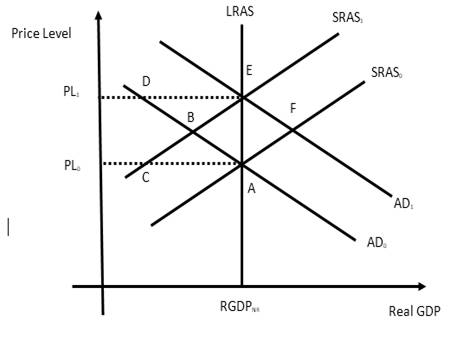
The economy was in the initial equilibrium at point A with the intersection of AD0 and SARS0. At point A, the expected price level and the realized price level are same at PL0. The equilibrium output RGDPNR is the also on the long-run
Now, suppose the government wants to lower the
As the expansionary fiscal policy is implemented, the aggregate demand curve shifts from AD0 to AD1with no corresponding shift in the short run aggregate supply curve due to unanticipated nature of the fiscal policy. A new equilibrium is established at point F in the short run.
Expansionary government policy:
The government policies that cause the aggregate demand of the economy to rise and thereby induce production and income along with the generation of employment is referred as the expansionary government policy. The tools used by the government for this purpose
(b)
To indicate:
The movement that represents an unanticipated contractionary government policy in the short run.
Answer to Problem 3P
The movement from equilibrium point F to equilibrium point A represents the unanticipated contractionary government policy.
Explanation of Solution
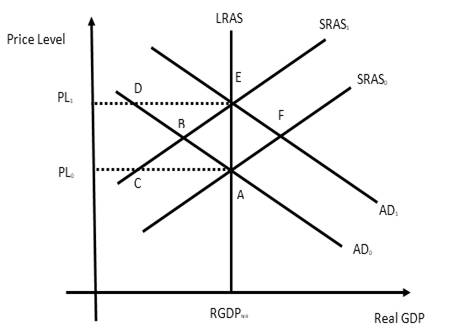
The economy is in the long run equilibrium at point A with real
To bring back stability to the economy, government takes measures that shifts the aggregate demand curve to the left to its original position, which is only possible when the government pursues a contractionary fiscal policy. However, if the contractionary fiscal policy is unanticipated, the public will maintain its expectation about the price level and therefore, the short run aggregate supply curve will remain unaffected. A contractionary fiscal policy affects the aggregate demand by lowering it from its current level for all prices and thereby shifting the aggregate demand curve back from AD1to AD0. With no change in the position of the short run aggregate supply curve due to the unanticipated nature of the policy, the shift in the aggregate demand curve will being the economy back to the old equilibrium at point A from point F.
Contractionary government policy:
The government policies that cause the aggregate demand of the economy to fall and thereby discourages production and generation of income along with employment is referred as contractionary government policy. The tools used by the government for this purpose are taxation and government expenditure. For the contractionary purpose, the government may either raise the tax rate or lower its expenditure or both. Contractionary government policy, also called contractionary fiscal policy, help the economy control inflation by lowering the circulation of money in the economy.
(c)
To indicate:
The movement that represents an anticipated expansionary government policy under the rational expectations.
Answer to Problem 3P
The movement from point A to point E represents completely anticipated expansionary government policy under rational expectations.
Explanation of Solution
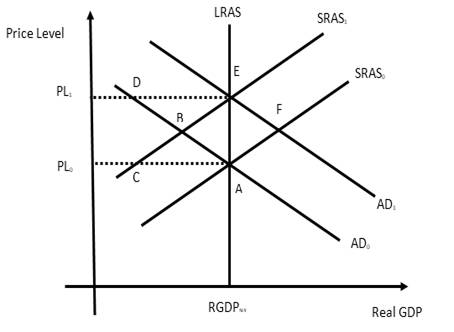
When an expansionary fiscal policy is completely anticipated, public by virtue of rational expectation will know from before that there will be a rise in the price level due to the policy. They immediately revise their activities and thereby changes the position of the short-run aggregate supply curve. Labor will revise their wages upwards; household will revise its spending; producers will lower production due to rising cost and so on which will shift SRAS0to SRAS1 even before the policy comes into effect creating a new short run equilibrium point at R. As the expansionary policy is implemented, the shift in the aggregate demand curve from AD0to AD1 generates the long run equilibrium at point F, where the economy is in the long run potential level of output with a higher price level.
Expansionary government policy:
The government policies that cause the aggregate demand of the economy to rise and thereby induce production and income along with the generation of employment is referred as the expansionary government policy. The tools used by the government for this purpose taxation and government expenditure. For the expansionary purpose, the government may either lower the tax rate or increase its expenditure or both. Expansionary government policy, also called expansionary fiscal policy, can help the economy move out of a recessionary situation.
Rational expectations:
People make decisions based on three primary factors, namely human rationality, available information, and experiences. The theory of rational expectation suggests that the current expectation of people can influence the future state of the economy.
(d)
To indicate:
The movement that represents an anticipated contractionary government policy in the short-run.
Answer to Problem 3P
The movement from point E to point F represents completely anticipated contractionary government policy in the short run.
Explanation of Solution
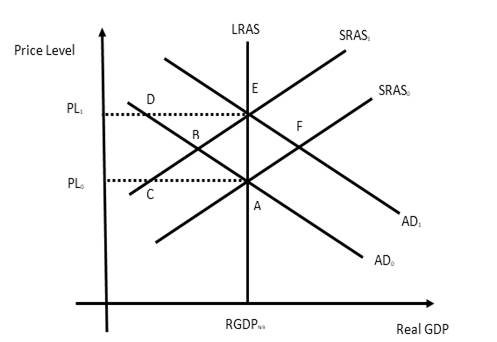
Suppose the economy is in long-run equilibrium at point E. At this point, the government plans a contractionary fiscal policy. If the move is completely anticipated, public will know from before that a contractionary fiscal policy will lower the price level. They will immediately revise their activities and that will cause the short run supply curve to shift rightwards from SRAS1 to SRAS0 even before the policy is implemented. Thus, the economy will move to a new short run equilibrium at point F.
Contractionary government policy:
The government policies that cause the aggregate demand of the economy to fall and thereby discourages production and generation of income along with employment is referred as contractionary government policy. The tools used by the government for this purpose are taxation and government expenditure. For the contractionary purpose, the government may either raise the tax rate or lower its expenditure or both. Contractionary government policy, also called contractionary fiscal policy, help the economy control inflation by lowering the circulation of money in the economy.
(e)
To explain:
The result of a situation where an expansionary government policy is made, but the inflationary effects of this policy is less than expected.
Answer to Problem 3P
If the expansionary fiscal policy results in the less than expected inflation, it will inhibit the growth in output and employment.
Explanation of Solution
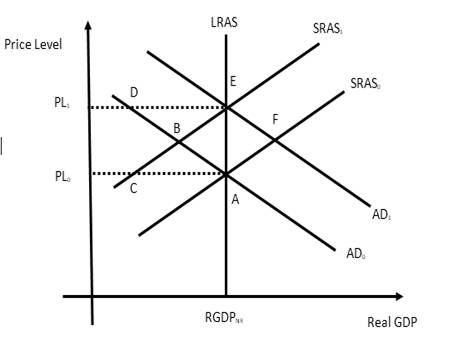
The expansionary fiscal policy boosts the aggregate demand which in turn puts an upward pressure on the price level. The rising price level encourages businesses to expand production level and generate income and employment. However, in case the fiscal policy fails to create the desired level of inflation, it will generate less impetus for the businesses to produce more and thereby inhibit the growth of output and employment.
Expansionary government policy:
The government policies that cause the aggregate demand of the economy to rise and thereby induce production and income along with the generation of employment is referred as the expansionary government policy. The tools used by the government for this purpose taxation and government expenditure. For the expansionary purpose, the government may either lower the tax rate or increase its expenditure or both. Expansionary government policy, also called expansionary fiscal policy, can help the economy move out of a recessionary situation.
Want to see more full solutions like this?
- Supply and demand functions show different relationship between the price and quantities suppliedand demanded. Explain the reason for that relation and provide one reference with your answer.arrow_forward13:53 APP 簸洛瞭對照 Vo 56 5G 48% 48% atheva.cc/index/index/index.html The Most Trusted, Secure, Fast, Reliable Cryptocurrency Exchange Get started with the easiest and most secure platform to buy, sell, trade, and earn Cryptocurrency Balance:0.00 Recharge Withdraw Message About us BTC/USDT ETH/USDT EOS/USDT 83241.12 1841.50 83241.12 +1.00% +0.08% +1.00% Operating norms Symbol Latest price 24hFluctuation B BTC/USDT 83241.12 +1.00% ETH/USDT 1841.50 +0.08% B BTC/USD illı 83241.12 +1.00% Home Markets Trade Record Mine О <arrow_forwardThe production function of a firm is described by the following equation Q=10,000L-3L2 where Lstands for the units of labour.a) Draw a graph for this equation. Use the quantity produced in the y-axis, and the units of labour inthe x-axis. b) What is the maximum production level? c) How many units of labour are needed at that point?arrow_forward
- what is change in TC / change in Q? and what would be an example?arrow_forwardhow to solve the attachment?arrow_forwardProblem 3-ABC Challenges: Attrition, Balance and ComplianceCan television inform people about public affairs? Political scientists Bethany Albertson and Adria Lawrence (2009) conducted an experiment in which they randomly assigned people to treatment and control groups to evaluate the effect of watching TV on a person’s information level. Those assigned to the treatment group were told to watch a specific television broadcast and were later asked questions related to what they watched. Those in the controlgroup were not shown the TV broadcast but were asked questions related to the material in the TV broadcast. The dataset contains the following variables: : Dummy variable which =1 if a person reads news and 0 otherwise. : interest in political affairs (not interested=1 to very interested=4) : years of education : female dummy variable (female=1; male=0) : family income in thousands of dollars : information level (low information level=1 to high information level=4) =1 if the…arrow_forward
- Problem 2-Experiments/Randomized Control Trial Suppose you are interested in studying the effect of academic counselling on the years it takes for a student to obtain an undergraduate degree. You conduct a randomized control trial to answer the question. You randomly assign 2500 individuals in a university in New York to receive academic counselling and 2500 students to not receive any academic counselling. a. Which people are a part of the treatment group and which people are a part of thecontrol group? b. What regression will you run? Define the variables where required. c. Suppose you estimate = -0.3. Interpret it. d. You test for balance using the variables mentioned in the table below. Based on the results do you think that the treatment and control group are balanced? If your answer is “yes” then explain why. If your answer is “no”, then explain why and mention how will you address the issue of imbalance. e. Suppose that some unmotivated students in the control group decided to…arrow_forwardHow to calculate total cost?arrow_forwardProblem 1-Experiments/Randomized Control TrialSuppose you are interested in studying the effect of being a part of the labor union on anindividual’s hourly wage.You collect data on 1000 people and run the following regression. where is a dummy variable which is equal t to 1 for people who are a part of labor union and0 for others. a. Suppose you estimate . Interpret b. Do you think is biased or unbiased? Explain. Now suppose you conduct a randomized control trial to answer the same question. Yourandomly assign some individuals to be a part of the labor union and others to not be a partof the labor union. The first step you take is to ensure that the randomization was donecorrectly. Then you estimate the following equation: =1 if the student is assigned to be a part of Labor Union=0 if the student is assigned to not be a part of Labor Union c. Why is it important to ensure that the randomization is done correctly? d. Name any two variables that you can use to test if Treatment and…arrow_forward
 Exploring EconomicsEconomicsISBN:9781544336329Author:Robert L. SextonPublisher:SAGE Publications, Inc
Exploring EconomicsEconomicsISBN:9781544336329Author:Robert L. SextonPublisher:SAGE Publications, Inc
 Economics (MindTap Course List)EconomicsISBN:9781337617383Author:Roger A. ArnoldPublisher:Cengage Learning
Economics (MindTap Course List)EconomicsISBN:9781337617383Author:Roger A. ArnoldPublisher:Cengage Learning







